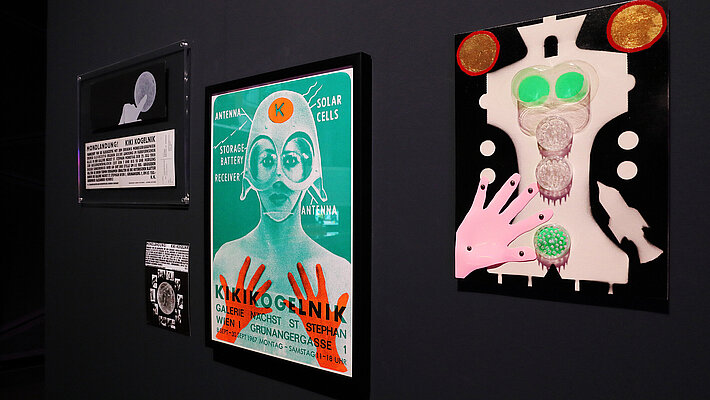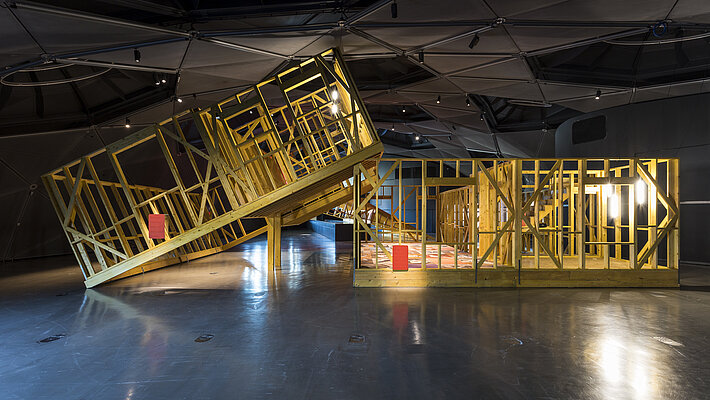|
|
|
|
|
|
21.04.2022
Bright colours, plastic and PVC, reduced forms, trivial and equally fetishized motifs from consumerism and advertising, mass media and comics, sexually permissive displays of femininity – this is Pop Art as we know it. The exhibition Amazons of Pop! at Space02 challenges the traditional art historical canon of what is generally regarded as Pop Art. Monica Bonvicini's exhibition for Kunsthaus Graz (Space01) is centred on themes that lie at the core of the artist’s research: an examination of architecture, literature and the construction of sexual and gender identity.
Amazons of Pop: feminist pioneers, questioning the traditional role of women
Bright colours, plastic and PVC, reduced forms, trivial and equally fetishized motifs from consumerism and advertising, mass media and comics, sexually permissive displays of femininity – this is Pop Art as we know it. But it can also be quite different: angry, daring, rebellious, openly erotic, subversively ironic as well as confrontational, inviting and activist. From the very beginning, self-confident and expressive female Pop artists shaped this art movement, which was for a long time dominated by men. The exhibition Amazons of Pop! challenges the traditional art historical canon of what is generally regarded as Pop Art. As feminist pioneers, female Pop artists with a lot of ‘Vroom, Bang, Ka-Pow! and Wham!’ questioned the traditional role of woman and muse. They worked autobiographically, often across genres as well as in different media, combining the bold aesthetics of a brave new world of commodities with the self-confident adoption of the new synthetic materials and technologies, while blending them with performance and also textile or paper crafts – for a long time ranked by art history as ‘low’ to even no art. From the early 1960s on, women artists unabashedly appropriated the broad repertoire of a metropolitan, consumer-oriented and media-reproduced awakening in order to challenge it in different ways and to take up their own unique positions within it: demonstratively approving like Sturtevant, openly provocative in their display of nudity and sexuality like Dorothy Iannone and Evelyne Axell, through demonstrative self-dramatization like VALIE EXPORT, or furious and explosive like Niki de Saint Phalle.
|
|

Installation view of "Amazons of Pop!" at Kunsthaus Graz, photo: Kunsthaus Graz/J.J. Kucek
|
|
|
|
|
|
|
|
|
|
|
|
European und Austrian Pop Art
The exhibition, initiated by MAMAC Nice and previously shown at the Kunsthalle zu Kiel, anchors Pop Art in Europe, explores links with the North American movement, especially in New York, and also examines Austrian Pop Art tendencies at Kunsthaus Graz. At a time when the US economy was prospering, its big cities glittering with lights, Vienna remained a dark and dirty place, struggling with the consequences of the Second World War. Until 1973 the euphoric Pop Art movement manifested itself in Austrian art in a rudimentary, marginal way, at times subliminally – in the weightless and flattened body silhouettes of Kiki Kogelnik, for instance, and the erotic, dreamlike yet equally brutal woodcuts of Auguste Kronheim, the fragmented and re-arranged advertising images and abstract compositions of Ingeborg G. Pluhar or the parasitic projects of Angela Hareiter, whose experimental architectural approaches are located at the interface with art.
Amazons of Pop! shows in a comprehensive way just how complex and heterogeneous women artists’ contribution to the history of Pop Art is, also integrating conceptual, activist and performative approaches. At Kunsthaus Graz, the exhibition design exploits an intrinsic affinity with the origins of blob architecture and, with around 120 works by some 40 female artists, superheroes and icons from various media such as painting, installation, performance, sculpture and film, encourages visitors to immerse themselves in the female world of Pop and a period of social, technological and political upheaval. It supports the successive recognition and public awareness of female Pop artists as well as a reappraisal and reassessment of conventional art history – as initiated by exhibitions such as POWER UP – Female Pop Art at the Kunsthalle Wien in 2010 – and takes them a step further.
With works by Evelyne Axell, Barbarella, Brigitte Bardot, Marion Baruch, Pauline Boty, Martine Canneel, Lourdes Castro, Judy Chicago, Chryssa, France Cristini, Christa Dichgans, VALIE EXPORT, Jane Fonda, Ruth Francken, Ángela García, Angela Hareiter, Jann Haworth, Dorothy Iannone, Jodelle & Pravda La Survireuse, Corita Kent, Kiki Kogelnik, Auguste Kronheim, Kay Kurt, Nicola L., Ketty La Rocca, Natalia LL, Milvia Maglione, Lucia Marcucci, Marie Menken, Marilyn Monroe, Isabel Oliver, Yoko Ono, Ulrike Ottinger, Emma Peel, Ingeborg G. Pluhar, Martha Rosler, Niki de Saint Phalle, Carolee Schneemann, Marjorie Strider, Sturtevant, Valentina Tereshkova, May Wilson.
Monica Bonvicini examines the construction of sexual and gender identity
The house, as the location for the construction of identity, as the domestic site in which relationships and desires are shaped, is a theme that Monica Bonvicini has been exploring since the early 1990s in works such as Haus Frau Swinging and Wallfuckin’. Destruction, natural disaster and climate crisis have been on her mind since the 1992 photo series Where Air Dwells, and over the last 15 years in her series of large black and white drawings, Hurricanes and other Catastrophes. Monica Bonvicini's exhibition for Kunsthaus Graz is centred on themes that lie at the core of the artist’s research: an examination of architecture, literature and the construction of sexual and gender identity.
Following the show at OGR in Turin, the large-scale architectural sculpture As Walls Keep Shifting is presented in Graz in a state of complete but calculated disaster. Half of a family house reconstructed in 1:1 scale is scattered across the exhibition space, as if a hurricane has just passed through and torn the structure apart.
|
|

Monica Bonvicini, installation view, "I Don’t Like You Very Much", © Monica Bonvicini and Bildrecht, Vienna 2022, photo: Kunsthaus Graz/M. Grabner
|
|
|
|
|
|
|
|
|
|
|
|
The show at Kunsthaus Graz starts with the video work I See a White and Blue Building (2020), which also provides the soundtrack for all of the installations. Other works included are the carpet of photos Breach of Décor (2020), the photo series Italian Homes (2019) as well as the cast of a little broom, Swept Away (2019). Accompanying the structure of As Walls Keep Shifting, a large print will be installed that is made up of collages of commercials and calendars featuring lots of skin. The mix of naked bodies, desires and ambitions as well as the use of bodies as commodity is also a key theme for the artist, who has also explored these issues in paper works such as Neck to Knees (2016) and Hard Strings (2017), and the series of Eternmales drawings (2000).
The question of home, commodity, desire and sex is continued in a new work, treating elements of fetish as sculptural and performative objects that invite the public – within the institutional context of the museum – to live out the voyeurism that is intrinsic to all museum visits.
________________________
Amazons of Pop! Women artists, superheroines, icons 1961–1973 and
Monica Bonvicini. I Don’t Like You Very Much
Kunsthaus Graz, Lendkai 1, 8020 Graz
Duration: 22.04.‒28.08.2022
www.kunsthausgraz.at
Please find more information and photos here: Amazons of Pop!
as well as here: Monica Bonvicini
________________________
We are looking forward to your coverage.
Kind regards
Daniela Teuschler
+43/664/8017-9214, daniela.teuschler@museum-joanneum.at
Stephanie Liebmann
+43/664/8017-9213, stephanie.liebmann@museum-joanneum.at
Alexandra Reischl
+43/699/1780-9002, alexandra.reischl@museum-joanneum.at
|
|
|
|
|
|
|
|